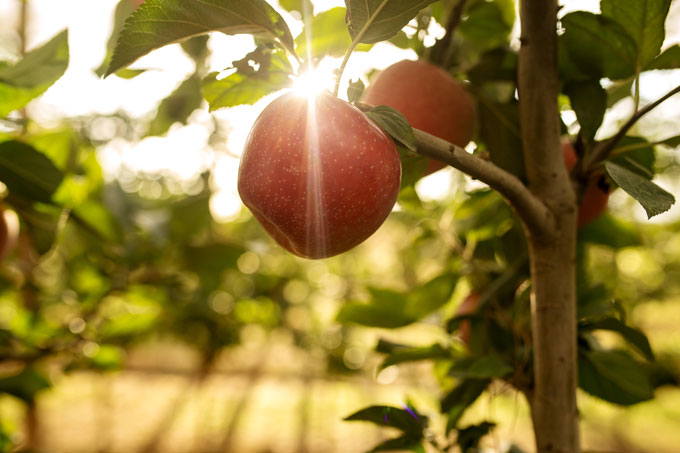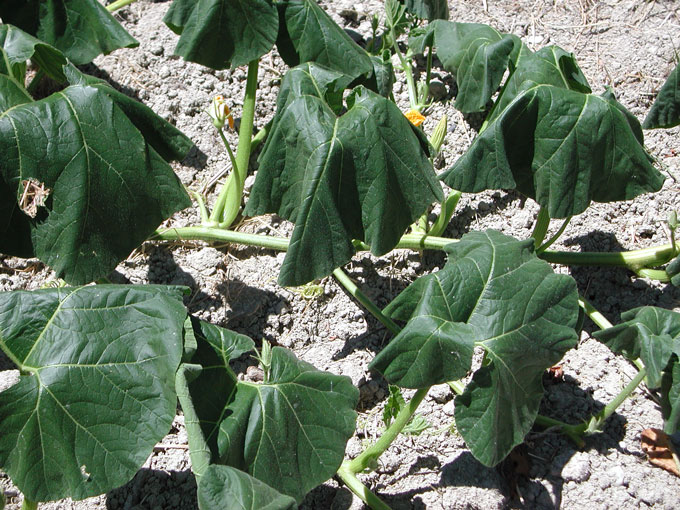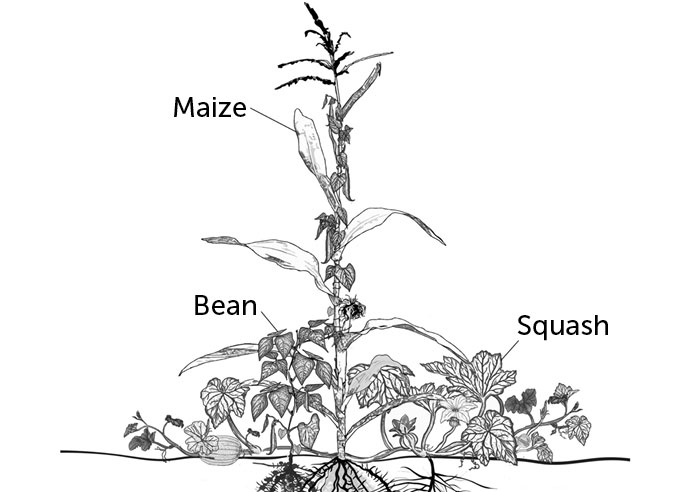In 2023, a new type of apple made its commercial debut at a trade show in Berlin. The tutti is fresh, juicy and has that perfect shade of brown – a wonderful cultivar that took decades to produce. But it has a bigger claim to fame: It’s designed to thrive in temperatures up to 40° Celsius (104° Fahrenheit).
The apple is a product of the Warm Climate Partnership, a collaboration between researchers and industry groups in Spain and New Zealand to create crops capable of thriving in increasingly warmer climates. The group came together in 2002 amid increasingly hot summers in Spain’s Catalan region that left the apples grown there sunburned and fried. After more than 20 years of crossbreeding for heat tolerance, Tutti (whose research name is HOT84A1) was discovered.

Now growing as far away as the United States, Chile and China, the tutti joins a growing list of fruits and vegetables that researchers are trying to weather the climate as the Earth warms. Using tools ranging from the old-fashioned—crossbreeding, reviving native plants, heat-conscious planting techniques—to the new, like gene editing, researchers are trying to help plant breeders and backyard gardeners stay afloat. one step ahead of the changing planet.
It is a long task. What felt hot 20 years ago is now commonplace, says Joan Bonany, a pomologist at the Institute of Agri-Food Research and Technology outside Barcelona, who helped form the Warm Climate Partnership. Memories of being able to walk comfortably between his neat rows of apple and pear trees “stretch further and further back in time,” he says, and preventing the future “is a lot like shooting a moving target.”
In some ways, Bonany says, Tutti is already outdated.
“Temperatures above 40 degrees Celsius, which are becoming more and more in our future, are going to create some real problems,” says Mario Andrade, a plant geneticist at the University of Maine at Orono and co-investigator in a project to created climate-resistant potatoes.
What happens to crops as temperatures rise?
To hit that moving target, scientists are starting with what they know about how plants handle heat.
Research has shown that even a slight increase in temperatures during the planting season can significantly weaken the yield of many plants. For example, globally, every 1 degree C rise amounts to a 10 percent and 6.4 percent loss in rice and wheat yields, respectively—foods that together with corn account for most of the world’s food calories.

But that’s just one of the many things that can go wrong when temperatures rise. Other signs of heat stress you may commonly see in your garden plants include drooping, slower growth, scorch marks on leaves and stems, smaller fruits and vegetables, or plants that flower but produce no fruit at all. crop – a sign that their pollen, which is sensitive to heat, has been damaged. Some plants even signal their distress vocally, making small ultrasonic clicks when they are very thirsty (SN: 3/30/23).
As temperatures continue to rise, the very proteins that perform a plant’s essential functions, such as directing photosynthesis, locking in water and nutrients, and warding off disease, begin to unfold and break down, says Owen Atkin, a plant scientist at the University Australian National in Canberra developing heat tolerant wheat. Plants can repair this damage using fast-acting heat proteins. And after 50°C (122°F), plants can begin to change the chemical composition of their cell membranes to keep their lipids from melting like butter left on the counter. But they do so at a cost.
“The cost of living while you’re trying to repair, repair, repair, because the degradation is getting faster, means you’re spending a lot more energy to survive,” Atkin says. “We’re going to need breakthrough work to protect against that kind of damage.”
Setting the freezer to heating
Most new plant varieties today are still produced as they have been for thousands of years, through a process known as selective breeding in which parents with desirable traits are crossed and their offspring born over successive generations until only the most the strong ones. It’s a long process, and there aren’t many ways to shorten it—”A plant grows as fast as a plant grows,” Andrade says—but there are new ways to make the process more efficient.
One of the most pressing challenges is that researchers and breeders must balance conflicting needs. A plant that is heat tolerant but disease susceptible will not sell, nor will one that is disease resistant but produces low quality fruit. Each of these traits can be controlled by hundreds of genes, all of which interact in unexpected ways. It’s a data nightmare that makes studying the genetic basis for various traits a challenge.
Now, however, the ability to control a plant’s entire genetic code has ushered in a new era of genome-assisted breeding, in which scientists still make crosses but use modern tools to guide their selections. For example, scientists can now compare the genetic makeup of different cultivars to investigate which features of their DNA might give one strain greater heat tolerance than another. This also negates the need to wait for each generation to grow old enough to demonstrate a trait. Researchers can now quickly look at a cultivar’s genetic code to identify whether a cross has a desired gene and narrow down their list of potential contenders.
Only by knowing the exact genes that drive a trait can breeders begin to manipulate them, says Rajeev Varshney, director of the Center for Crop and Food Innovation at Murdoch University in Perth, Australia. This manipulation can include genetic modification, in which a gene from one species is added to another, or gene-editing tools such as CRISPR/Cas9 that allow scientists to modify small pieces of a plant’s code — changes that have produced strawberries , climate-friendly tomatoes. and potatoes.
In one study, researchers identified a gene called AtGRXS17 in Arabidopsis, a small plant from the mustard family widely used in research, that appears to be involved in drought tolerance. When they added the gene to tomatoes and withheld water for 10 days, the modified plants retained their energy and produced fruit, while plants without the gene did not. In another, using CRISPR/Cas9 to edit a single gene called FaPG1 produced firmer strawberries that held more water.
At the moment, the use of these latter tools remains expensive, and so it is more often private companies that develop them for large-scale operations. As such, most edited crops are out of reach for the average gardener at the moment. The first cultivar marketed directly to home gardeners was released only recently, in February 2024 – a deep purple tomato that gets its color thanks to several genes extracted from snapdragon flowers.
But Varshney notes that costs are falling all the time, and it’s likely we’ll soon see more options available to consumers. “In the next few years, breakthroughs will come much faster,” he says. “I feel very optimistic that we will have many more heat and drought tolerant plants.”
Can we use any past techniques for future crops?
It is possible to buy traditionally bred seeds from commercial companies that are marketed as “heat tolerant” – meaning they grow relatively well in hot conditions compared to non-adapted strains. But a growing movement is encouraging gardeners to take their plants locally, especially if you already live in a hot location.
Even a specially developed plant like Tutti may not thrive in every new location, but plants that have been bred locally are often uniquely adapted to a region in ways we don’t yet fully understand. Native communities throughout the American Southwest, for example, excel at growing heat-tolerant varieties, says Andrea Carter, a member of the Powhatan Renape Nation and director of agriculture and education at Native Seeds SEARCH, a public seed bank in Tucson that preserves drought diversity. adapted seed.

“These seeds have been grown for hundreds, sometimes thousands of years in a particular location — that’s a lot of work that went into adapting these plants,” she says. “In the future, much of the world will face high temperatures and low water availability, and so the seeds of this region are a real resource that is already becoming more valuable.”
How you grow your plants can also give them an edge (SN: 3/9/23). The “three sisters” method involves growing a trio of corn, beans and squash together, each providing benefits to the others. The beans fix nitrogen in the soil for the corn, whose long stalks provide a cage for the beans, and the low-growing squash shades the soil. Covering the soil with straw or mulch or using shade cloth provides a similar benefit, and Carter says that deep but infrequent watering is better than drip irrigation to encourage roots to grow, where they are less likely. prone to drying out.
“Desert-adapted plants do this naturally, but others may need a little prodding,” says Roslynn McCann, a sustainable communities researcher at Utah State University in Moab. “In some ways, I think gardening under climate change has become a little more practical that way. It’s less about throwing seeds and seeing what grows, and more about doing what you can to give your plants a leg up.
#scientists #fruits #vegetables #resilient #climate #change
Image Source : www.sciencenews.org
